Editorial note -
TheCatSite.com does not advocate feeding raw food to cats. Over the past years, leading veterinary organizations have published statements on the topic.
They all advocate against feeding raw food to cats, commercial or homemade.
If you're considering switching to a raw diet, please take a minute to follow these links and read the full statements -
Statement by the AVMA (American Veterinary Medical Association) -
"The AVMA discourages the feeding to cats and dogs of any animal-source protein that has not first been subjected to a process to eliminate pathogens because of the risk of illness to cats and dogs as well as humans."
Statement by the AAHA (American Animal Hospital Association) supported by the AFFP (American Association of Feline Practitioners) -
"Based on overwhelming scientific evidence, AAHA does not advocate nor endorse feeding pets any raw or dehydrated nonsterilized foods, including treats that are of animal origin."
Statement by the CDC (Center for Disease Control) -
CDC does not recommend feeding raw diets to pets. Germs like Salmonella and Listeria bacteria have been found in raw pet foods, even packaged ones sold in stores.
These germs can make your pets sick. Your family also can get sick by handling the raw food or by taking care of your pet.
However, as a community, we understand that cat owners may decide against all recommendations and feed their pet a homemade or commercial raw diet.
To help minimize the risks, we decided to keep the following guides on the site. They were all written by Laurie Goldstein, who has contributed to our site over the years.
The opinions expressed below are Laurie's and are not endorsed by TheCatSite.com.
Homemade Food For Cats: Consider Your Recipe!
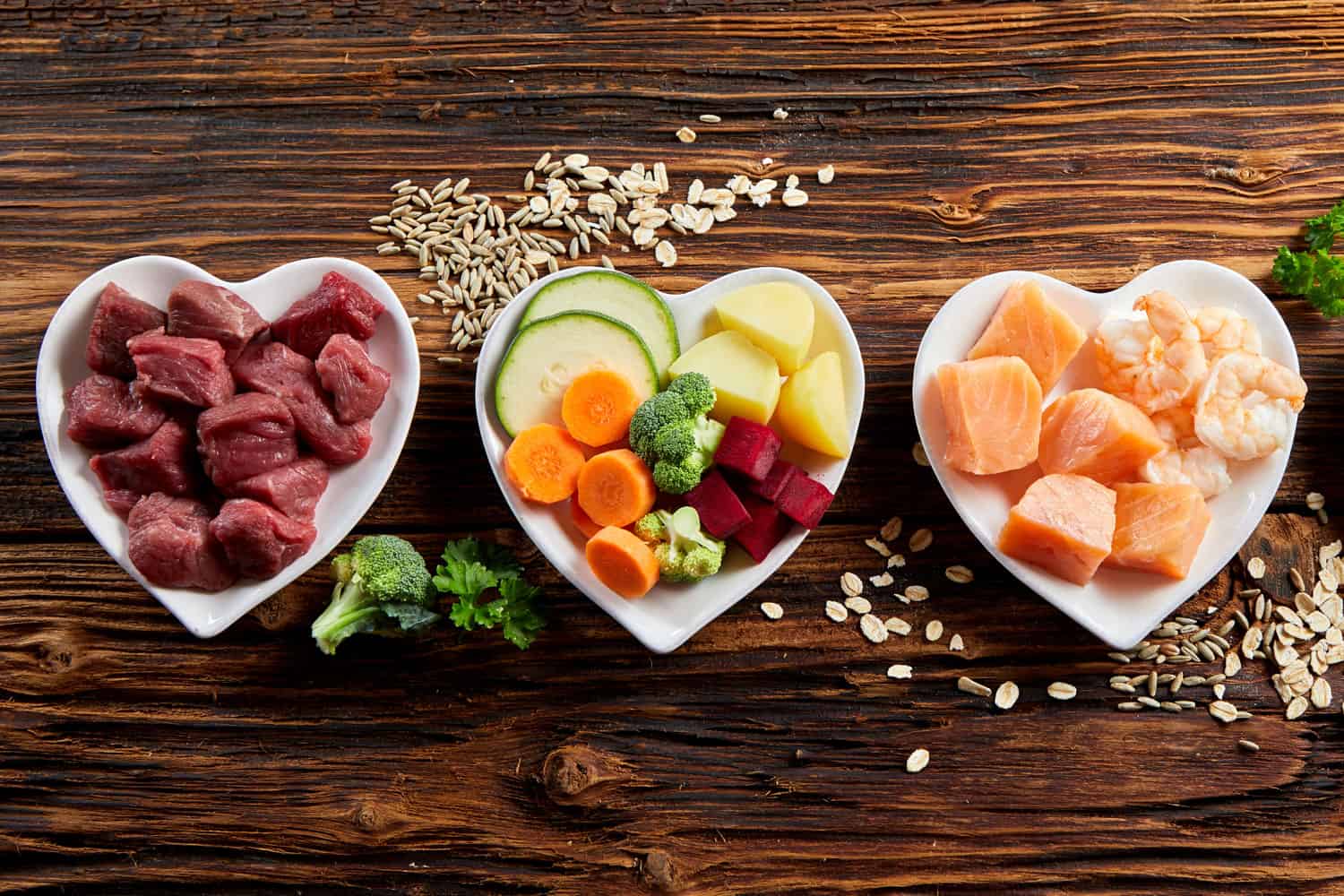
Google “homemade cat food” and you will get almost 33 million results. There are recipes galore, YouTube videos, and many strong opinions on the subject.
Challenges and Misconceptions
Our vets often discourage us from making cat food ourselves, and articles often indicate that it is difficult, that it requires a lot of work, that we have to use a lot of ingredients and supplements. And we’re left feeling like we need to be rocket scientists to feed our cats unless we buy commercially prepared food.
Of course, it requires care and learning.
The Simplicity of DIY Cat Food
But it doesn't require a Ph.D., as there are nutritionally balanced recipes and approaches already formulated that we can use.
We do not need to reinvent the wheel, so to speak.
We just need to learn how to choose a recipe wisely, based on an understanding of our cat's needs and factoring in the source of the recipe: is it a vet?
A veterinary nutritionist?
Has the recipe been analyzed?
Or is this some random person on the internet with no particular knowledge about feline nutrition?
In the wild, cats eat small prey animals.
Modeling homemade cat food after what they naturally eat results in a diet that many people find to be surprising in just how close to meeting the AAFCO or FEDIAF definitions of “balanced and complete” it is.
It actually takes very little supplementation to create a homemade nutritionally balanced diet when proper ingredients in the correct proportions are used.
As cats are obligate carnivores, it really shouldn't come as any surprise that diets created from animal-based ingredients in the proper quantities and proportions need little supplementation to meet their nutritional needs.
Utilizing Scientific Resources
This has been demonstrated by TheCatSite member, mschauer. They have taken great care in developing a program to analyze diets using the USDA National Nutrient Database and comparing the results to AAFCO and FEDIAF feeding guidelines.
Links to nutritionally balanced raw and cooked recipes (and analyses) are provided in the Raw & Home-Cooked Cat Food forum.
But there are limitations to this type of computer analysis, as discussed in a thread about balancing homemade recipes in the Nutrition Forum:
- Nutrient data are averages. The actual nutrient values of the ingredients we use at home may not match the data in the USDA National Nutrient Database.
- A true and accurate nutritional profile of a diet can only be determined by laboratory analysis. These are very expensive, on the order of several thousand dollars.
The American Association of Feed Control Officials (AAFCO) is a U.S. agency that provides feeding guidelines for pets.
The European Union regulatory body is the European Pet Food Industry Federation (FEDIAF).
Reliability of Computer-Based Analysis
However, a study conducted by UC Davis researchers evaluating recipes for home-prepared dog foods found that when comparing computer-based analysis with laboratory analysis, the data supported the concept that computer-based analysis is, in fact, a reliable method for analyzing recipes.
Thus utilizing the USDA database to ensure homemade recipes meet AAFCO and/or FEDIAF nutritional recommendations does afford confidence we are providing a nutritionally balanced diet to our pets.
Is the AAFCO the bar we need to meet?
This same UC Davis study also found that “very few of 200 recipes analyzed provided all of the essential nutrients in amounts adequate for meeting established canine health standards.” [Even though many of the diets are designed by veterinarians.]
How can this be?
AAFCO and FEDIAF base their daily nutrient guidelines on the recommendations in the Nutrient Requirements of Dogs and Cats (2006).
These recommendations have a rather wide safety margin built into them. This is an acknowledgment of the many factors that impact the availability of nutrients to each individual pet.
Nutrient Absorption and Food Types
To provide just one example, extruded diets (dry kibble) are not as easily digested as raw or cooked foods.
Yet nutrient guidelines must ensure that every diet can meet the needs of our pets. [No matter what form of diet is fed.]
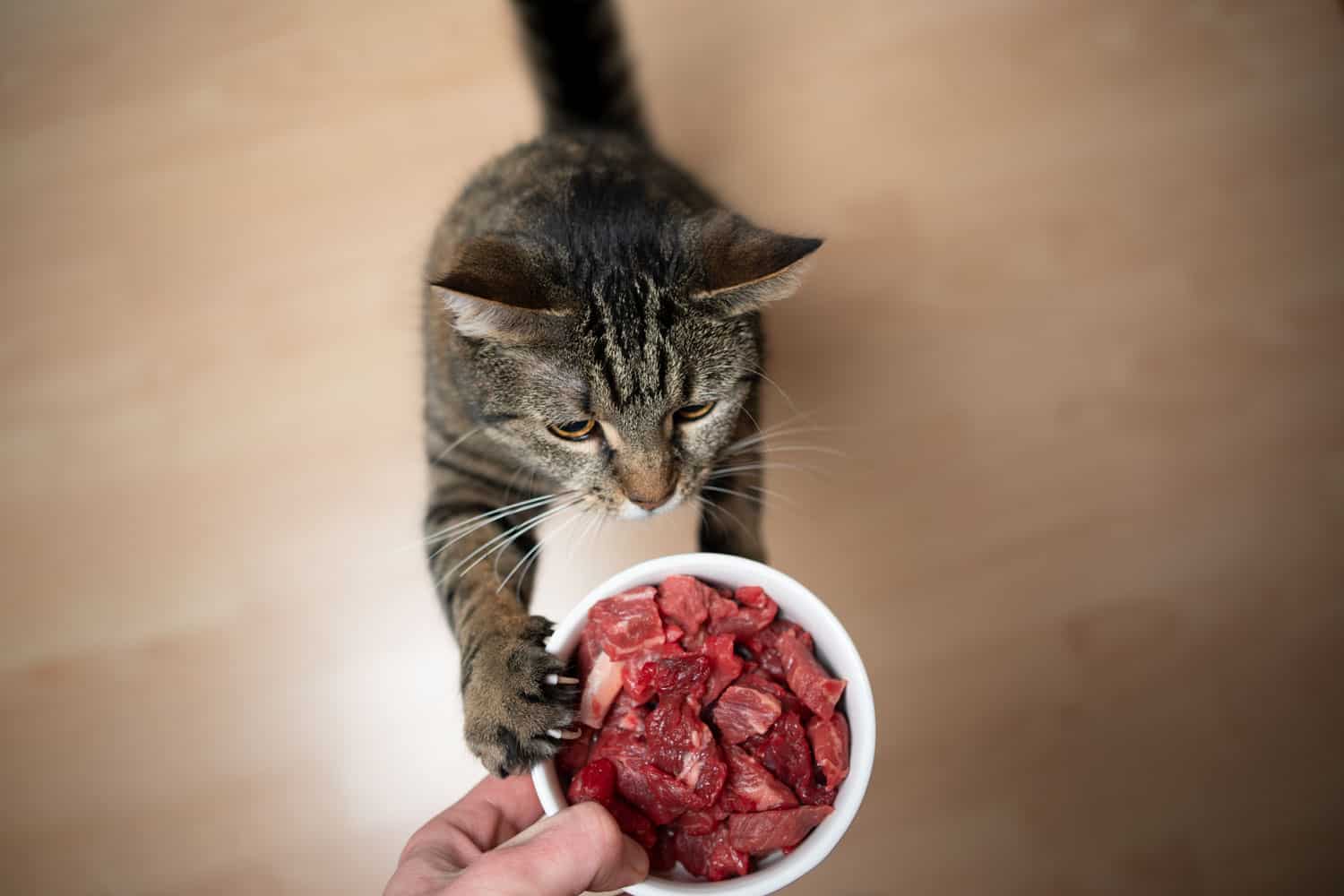
When feeding a minimally-processed, fresh diet with human-quality ingredients, some recipe designers use nutritional guidelines as a starting point.
They leverage their knowledge of cats' nutritional needs. Additionally, they possess the ability to evaluate recipes based on agencies' daily nutrient recommendations.
They also consider the built-in safety margins.
Longevity and Current Nutritional Guidelines
Pet parents might be skeptical about the ingredient quality in commercial food when considering a homemade diet.
However, cats fed on diets following AAFCO/FEDIAF nutrient guidelines are thriving. Coupled with indoor living and proper veterinary care, many of these cats live into their teens and 20's.
Thus these guidelines should be considered an important tool in developing a homemade diet, even if they are not a perfect science.
We admittedly don’t know if the recommendations, as they exist, provide the ideal long-term (lifelong) nutrition for our cats.
But they are the best guidelines we currently have, and as such, should not be dismissed.
The Challenge of Crafting a Balanced Raw Diet
If you are considering feeding raw or are just beginning to feed raw, please be aware that trying to formulate a nutritionally balanced diet on your own is not easy.
There is a steep learning curve.
It makes much more sense to evaluate existing recipes, considering the source and depth of discussion by the author on the nutritional adequacy of the recipe because there are many published recipes that are deficient.
Using a recipe that is not nutritionally balanced will harm your cat. If you need help evaluating a recipe, please start a thread in the Raw & Home Cooked Nutrition forum asking for assistance.
Raw Feeding For Cats: The Ingredients
Feeding a homemade raw diet, or any homemade diet for that matter, means you are responsible for providing complete and balanced nutrition for your cat.
As many TCS members can tell you (given half a chance, they will!), it doesn't have to be complicated, as long as you follow the right recipes or the prey model raw guidelines.
Click here for an in-depth article about choosing the right ground recipe (including links to suggested recipe resources).
Prey Model Raw feeding will be discussed in a separate article.
Please note that the supplements included in-ground raw recipes are not optional. They provide critical nutrition to account for
- Nutrients potentially not provided by the food sources in the recipe and
- Nutrients that may be impacted by oxidation due to grinding or freezer storage
Even with the best recipes, you need good ingredients to get the perfect dish.
The same is true for home-prepared raw cat food.
Let us go over the main components of homemade raw cat food and see what you have to look for.
What Meat Do I Use?
In the wild, cats aren't hunting cows, pigs, sheep, or deer, yet as opportunistic feeders, feral cats will eat a meal of any of these if they encounter an already dead animal.
Cats also aren't naturally big bird eaters. Cats are rodent specialists, but for most of us, the mouse isn't going to be on the menu. So what do we use?
Anything we eat and can source! Ideally, we want meat that is hormone-free, antibiotic-free, and “pastured” or free-range.
But almost any human-quality meat and organ provides an excellent source of nutrition for your cat. There are a few considerations to be aware of:
Type of meat
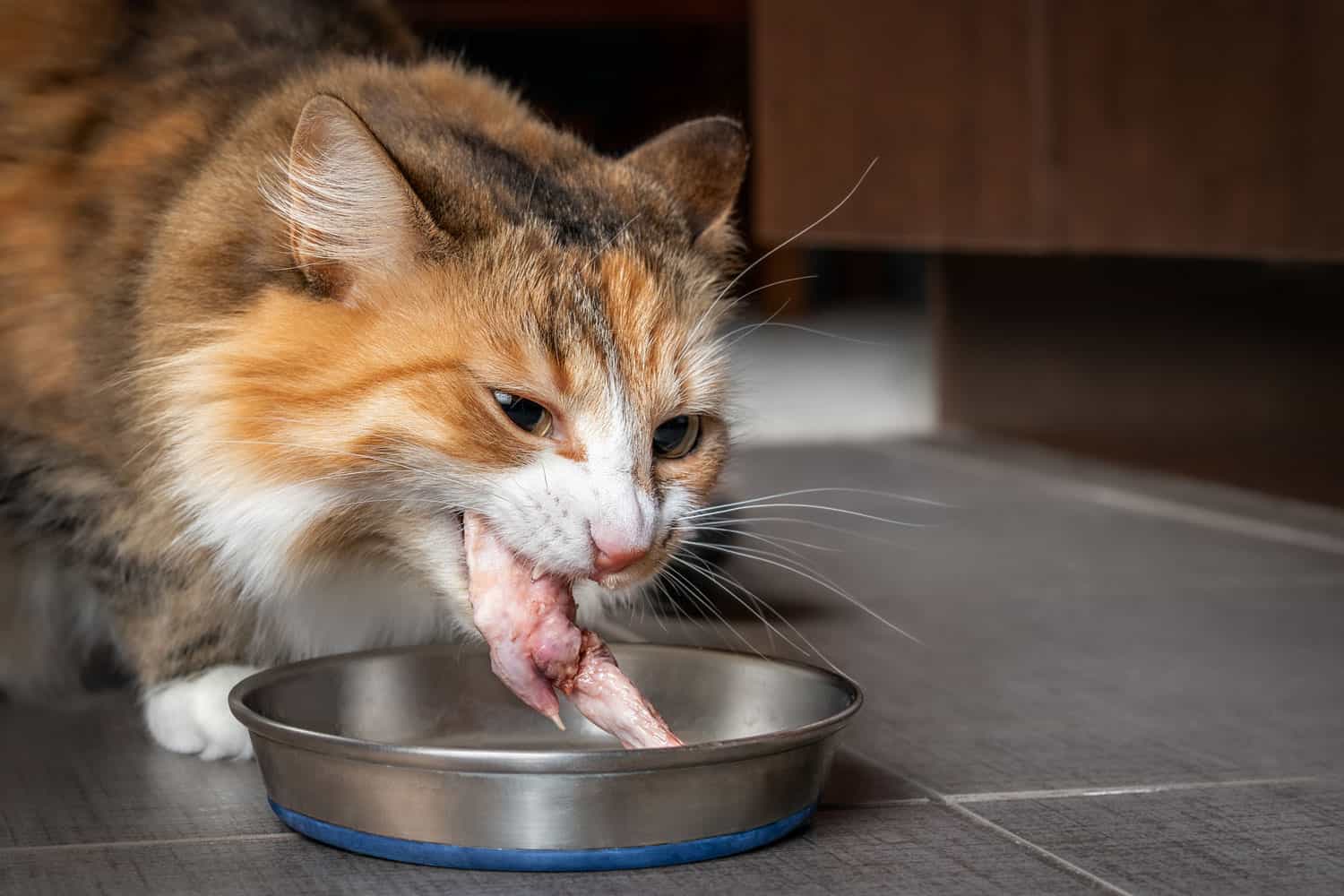
Poultry, and not surprisingly, rabbit, do seem to be better tolerated by kitties out of our human-sourced protein options, so these are often a good place to start for your slow transitions to raw.
Red meats (other than venison) typically have more fat than poultry and rabbit and provide a higher fat profile than our indoor kitties (usually) need for energy.
So it is best to include these in the rotation rather than providing them as a sole-source diet.
Including a rotation of different proteins – both muscle meat and organs – is always a good idea, due to the different nutritional profiles of each.
In fact, within protein categories, each different cut of meat will have a different nutritional profile. Dark meats (heart, thigh, shoulder) are more nutrient-dense and higher in taurine, for instance than lighter muscle meats.
“Organic,” “Naturally-raised” and similar labels
The rules and requirements for raising organic meat animals are clearly defined, but the standards for meat animals deemed “Naturally Raised” are more flexible.
They are voluntary standards that are not enforced. “Naturally raised” does not necessarily mean “pastured,” which is what most consumers expect.
The voluntary standard is intended only to mean that the meat has been minimally processed, does not contain artificial flavor, coloring, or chemicals, and the animals were not given growth hormones or antibiotics to boost growth rates.
Pastured, grass-fed (and finished) grazing animals and pastured poultry have different nutritional profiles than animals raised in factory-farmed conditions.
One of the main differences in grazing animals is a favorable fat profile that is higher in anti-inflammatory omega 3s. If you can afford pastured, grass-fed, and finished meat, it is healthier for your cat (and you!).
If you can afford antibiotic-free, hormone-free meats, these are preferable, but not a requirement.
Enhanced Meats
Do not purchase enhanced meats. This means (at a minimum) that the meat has been soaked in a salt solution and will provide too much sodium.
Labels often do not clearly identify the meat as having been enhanced. The only way to know for sure is to check the sodium content. In the U.S. one serving of meat is defined as 4 ounces.
If one serving of 4 ounces has more than 100mg of sodium, the product is enhanced and is not suitable to feed your cat.
Any meat product can be enhanced, but it is a practice most notably found in poultry meats (particularly turkey breast and duck) and in pork.
Ground Meat
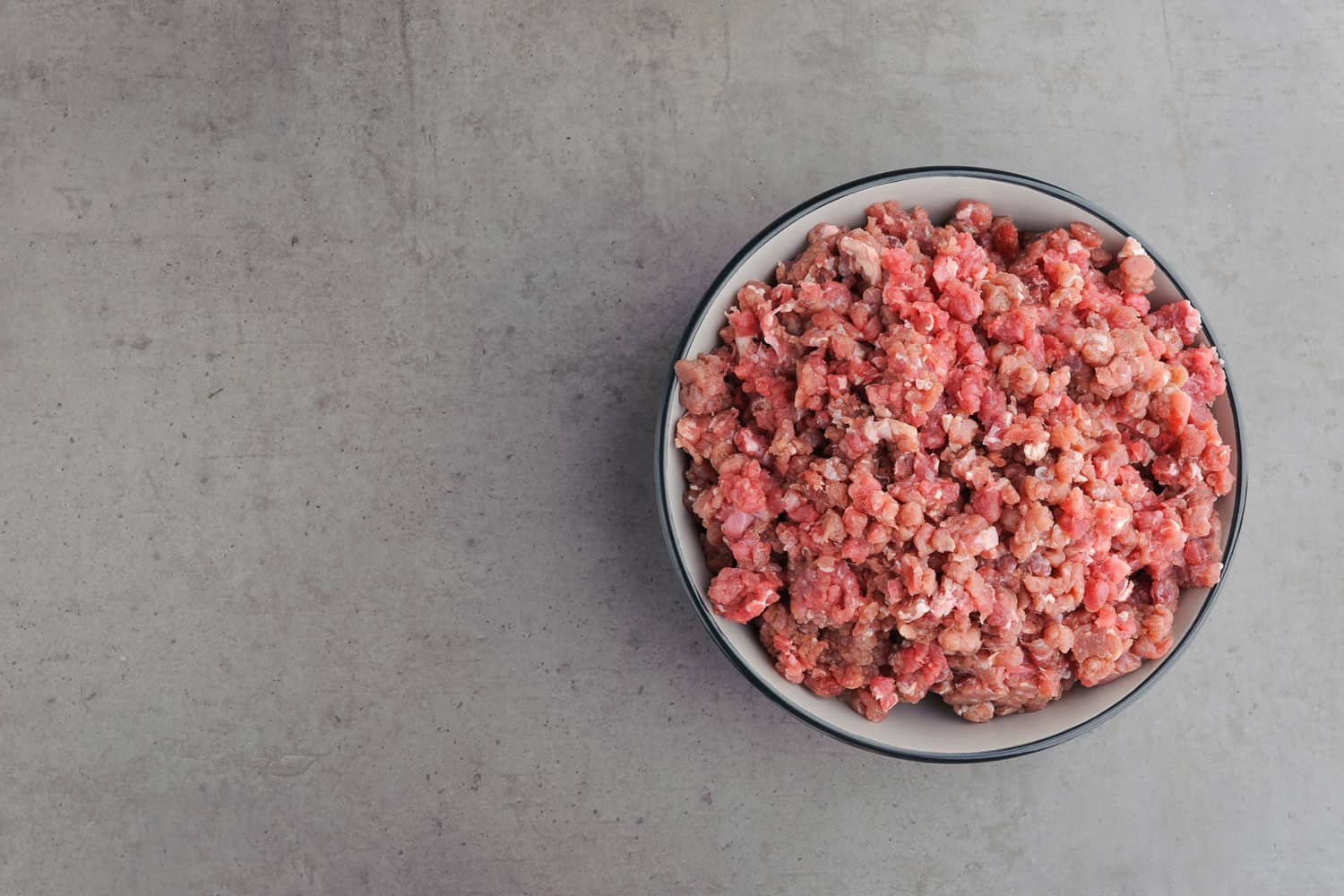
Do not purchase already ground meat. Commercial grinding increases the chance of bacterial contamination, and grinding exponentially increases the surface area of the meat, leading to a more rapid rate of oxidation and potential nutrient loss – and it can sit out on display for days.
Unless the ground meat was flash-frozen and intended for use as raw pet food, it is best to grind your own at home.
Bones or Bone Alternatives
Bones are an important source of calcium and many other minerals. Bone or bone alternatives are always included in balanced raw food recipes and prey model raw-style feeding.
Organs
Organs are a vital component of any raw recipe. Though a small portion of the overall diet, they provide critical nutrition.
Secreting organs such as the liver and kidney are very nutrient-dense and provide levels of needed nutrients not found in muscle meat.
Many people have difficulty sourcing organs other than the liver, so most recipes call for only the liver, though the addition of a second secreting organ greatly enhances the nutritional value of the food.
Varying the protein source of the liver in different batches of food will provide a wider variety of nutrients to your cats, as the livers of each animal have different micronutrient and mineral profiles.
If all you can source is chicken liver, never fear, that will be sufficient.
Some recipes recommend you utilize the same animal protein and organs in the recipe.
I am not familiar with the reason for this practice – other than the potential importance of providing single-source protein meals for cats with inflammatory bowel disease, and prior protein allergies (though many raw feeders report their pets aren't allergic to the proteins when fed raw), or for pets with generally sensitive gastrointestinal systems.
For most cats, variety within a meal is healthy and enjoyable.
Taurine
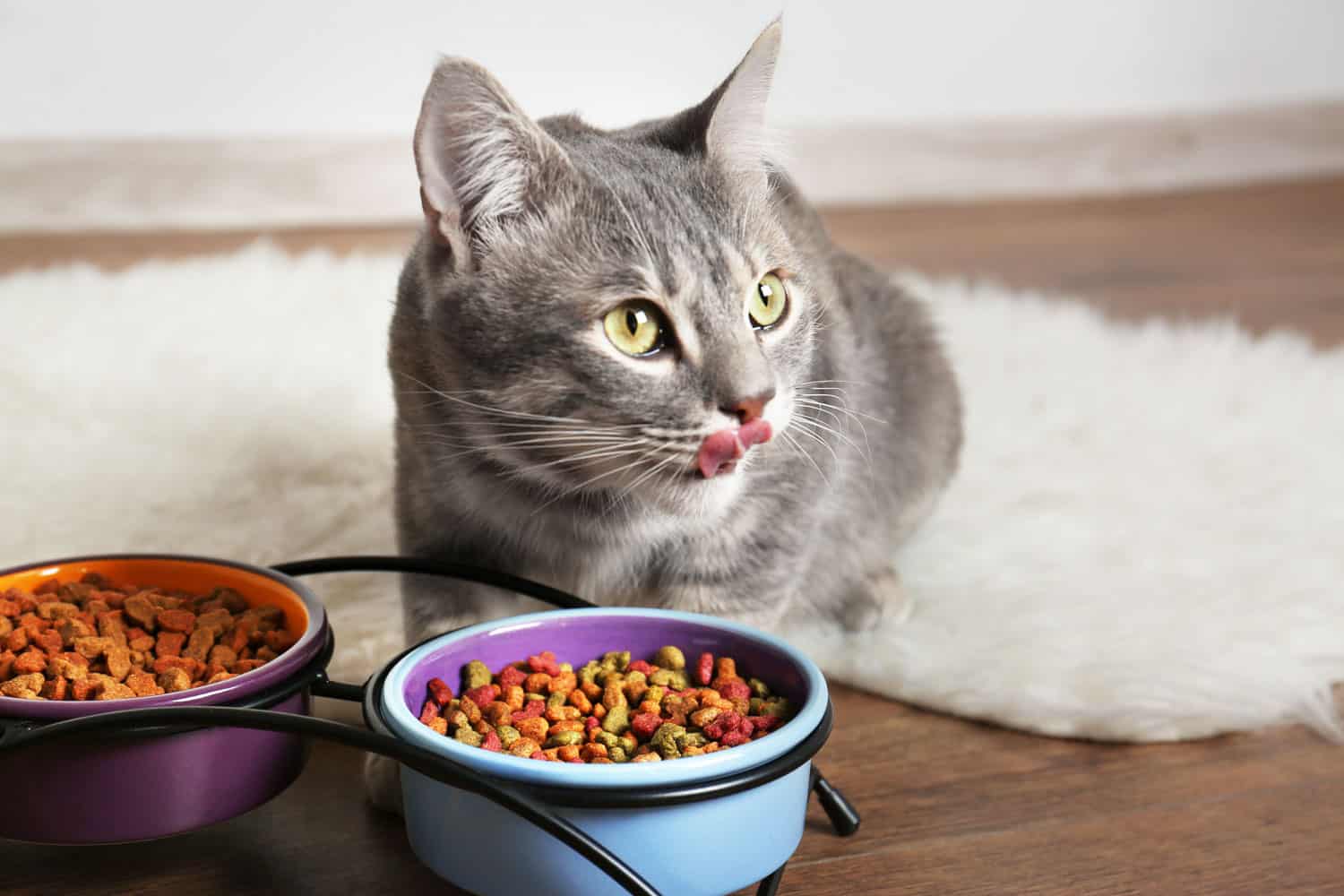
Taurine is not defined as an essential amino acid in humans, but it is in cats. Cats must have taurine in their diets to prevent heart failure and blindness.
Taurine is concentrated in electrically active tissues such as the heart, brain, eyes, and dark meat muscles.
As processing impacts taurine (even just grinding), if the ground recipe you are evaluating does not contain taurine as a supplement, you are putting your cat at serious (potentially fatal) risk.
If feeding PMR, include hearts and dark meats to ensure sufficient taurine for your kitties.
Eggs
Eggs are an important source of choline, vitamin D, and healthy omega-3 fatty acids. If a recipe you are evaluating does not contain at least egg yolks, please do not consider using it.
Some recipes call for whole eggs, and many call for just the yolks.
Some people are concerned about providing egg whites due to their familiarity with the issue of avidin, a strong biotin-binding nutrient in egg whites when fed raw.
Egg yolks, however, are high in biotin.
Fed together (whites and yolks), your cat is not at risk for biotin deficiency.
If you are using egg whites to increase protein values and lower phosphorus in a balanced recipe for your cat with kidney disease, then egg whites should be cooked prior to inclusion in the food.
The nutritional difference between eggs of organically-raised, pastured chickens and battery-raised egg-laying chickens is stark and evidenced by the deep orange color and size of the yolk relative to the egg in the first, and the small, pale yellow yolks of the latter.
If you cannot source locally-raised, organically fed, pastured chicken eggs, purchase the “Omega” eggs sold in many supermarkets if that is an option in your location.
Fed a special feed that increases the healthy fat profile of the yolks, these egg yolks will provide a superior source of nutrition to your cat than traditionally fed chicken eggs.
Raw Feeding Cats: Calcium And Bones
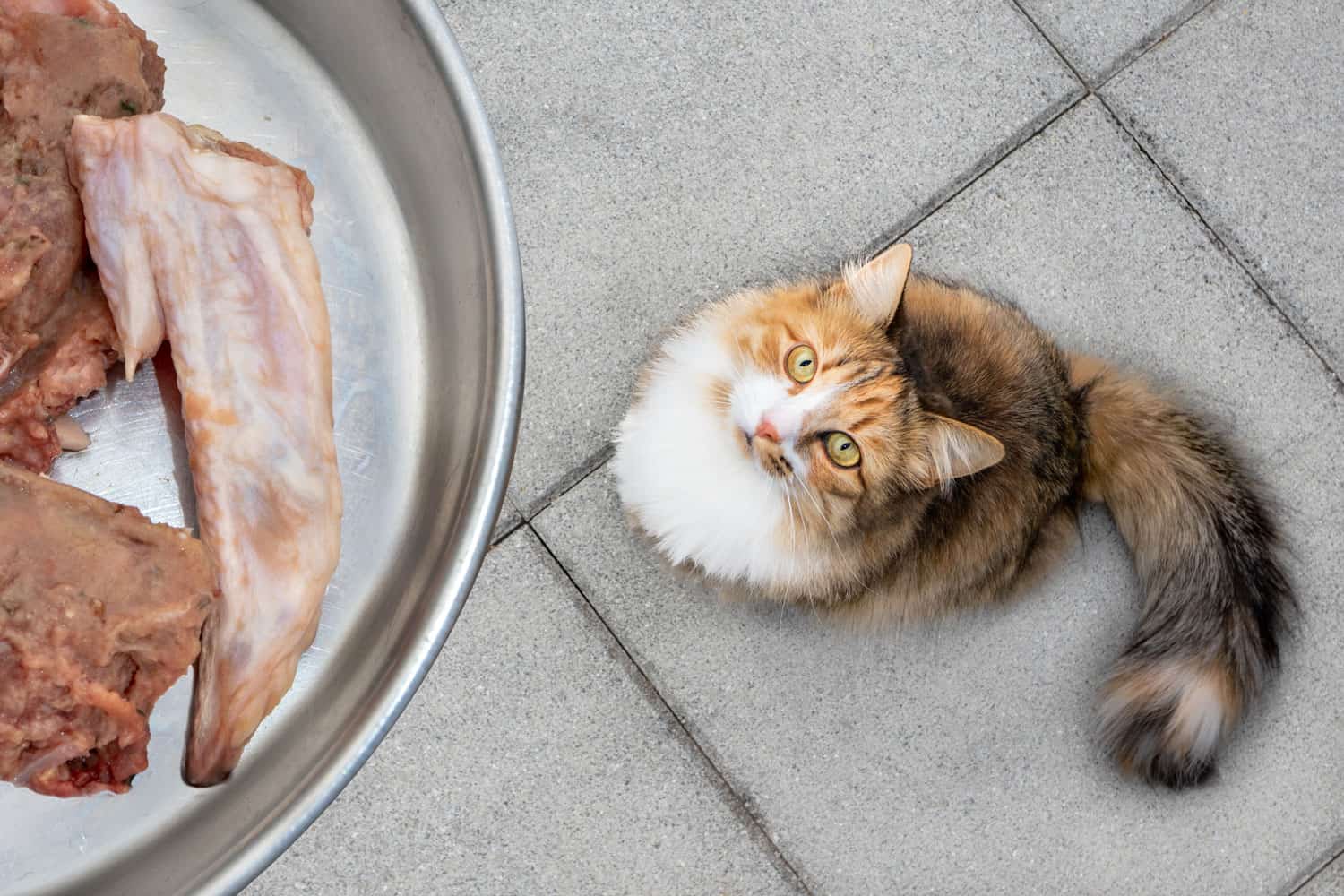
If you're feeding raw or are considering the option, you need to make sure the cat's diet is complete and balanced.
If you're feeding homemade raw, using a nutritionally balanced recipe is key. Take a few minutes to read our discussion on finding the right recipe for feeding homemade raw.
A balanced recipe is important for many reasons, a critical one being calcium content. It often leads to questions about how to use bones or bone alternatives in the cat's diet.
This short guide explores the issues of calcium and how to incorporate it into a homemade diet.
Coming up with your own recipe for feeding raw is very challenging, not only in regards to calcium, and should not be attempted by anyone who is not a cat nutrition expert.
For almost everyone else, feeding raw means either consulting with a pet nutritionist for a tailor-made diet.
What is Calcium and Why is it So Important?
Calcium is one of the most important minerals for a mammal’s body.
Many of us are familiar with calcium as a key nutrient in fighting the onset of osteoporosis and indeed it does have a key role in building bones and teeth.
But calcium is also crucial for various physiological processes in body cells, including helping to clot blood, send and receive nerve signals, make your muscles work properly, and perhaps most importantly, keep a normal heartbeat.
Calcium works together with numerous nutrients, notably phosphorus, magnesium, and vitamin D.
When it comes to calcium, dietary considerations take into account not only the actual amount of calcium in the diet but also the critical balance between calcium and phosphorus, known as the “calcium-to-phosphorus ratio” Ca: P.
The all-too-common practice of feeding meat without bones (or an alternate source of calcium) is nutritionally disastrous.
If the Ca: P ratio is not right, the cat will leech calcium from their very bones, resulting in a condition that can become fatal and irreversible.
Do not try to guess your way around adding bones to your cat's homemade raw diet, whether feeding ground or not.
Stick to a known recipe—properly balanced recipes (or prey model raw feeding guidelines) will clearly address this critical relationship, defining how to determine the amount of bone to use.
Otherwise, take time to learn more about the types of calcium and how to balance them within a recipe. If in doubt, consult a pet nutritionist.
Feeding Bones
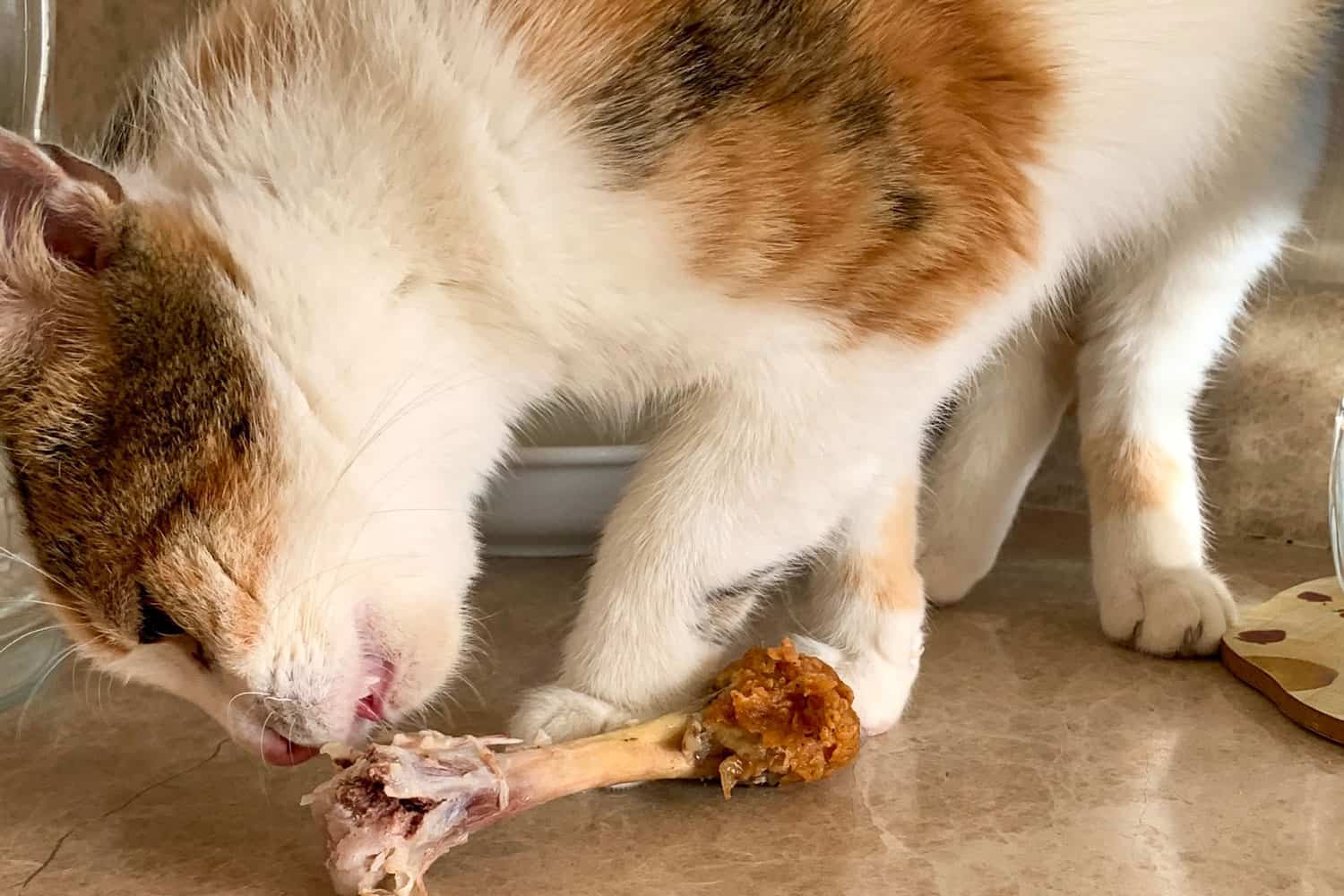
Owners who feed prey model raw, i.e. do not grind the ingredients, feed their cats fresh whole bones inside their "meat" packages.
Only smaller bones are appropriate for a cat, similar to that one might find in a rat or a bird. The bones are served in their natural state, forcing the cat to chew the meat (or meat and skin) and break down the bone inside it.
Larger bones are not suitable for cats, so should not be used in prey model (non-ground) feeding.
Examples of appropriate bone-in meals for cats include rabbit, quail, pheasant, dove (if you can source it), Cornish hen, chicken ribs, and the two smaller pieces of a chicken wing.
This will be discussed in more detail in an article featuring prey model raw feeding.
Many veterinarians warn against feeding bones to cats. It is a risk that should be acknowledged.
Experienced feeders of raw claim they rarely see any issues with bones getting lodged in a cat's mouth or throat, and that when that does happen, the cat usually manages to expel the bone pieces on her own.
The risk is considered minimal, as long as the right kind of bone is served.
According to owners who feed raw, the benefits of feeding raw bones the right way - mostly improved dental health - outweigh the associated risks.
Never feed cooked bones. Cooked bones are dangerous, regardless of their size. Fresh bones are soft and flexible. Cooked bones are brittle and shatter and can cause internal damage.
SIGN UP FOR THECATSITE'S EMAIL UPDATES >
Alternative Sources of Calcium
Raw bones are considered to be the best source of calcium in a healthy cat's homemade diet.
You may find recipes that use alternative sources of calcium, either for variety's sake or intended for cats with specific health issues.
Here are some alternative sources, based on a discussion about bone alternatives held in our Raw & Home-cooked cat food forum.
Note that replacing any part in your recipe should be done with caution as ratios and quantities may be different compared to the original recipe.
Either find a reputable pet nutritionist to work with or a recipe that is based on the replacement. Still not sure? Post your question in the Raw & Home-cooked cat food forum.
Bone meal - Authors of recipes often provide instructions on how to use bone meal instead of fresh bone.
But due to the bone meal being made from older animals, typically raised in less-than-ideal farming environments, TCS members do not recommend using bone meal as a bone alternative.
Toxins can be concentrated in bone and the marrow.
Even though human-grade supplements must meet certain standards for the allowance of heavy metals in supplements, given the high heat to which the minerals and marrow are subjected, there are superior options.
MCHA (Microcrystalline Calcium Hydroxyapatite) - this is simply freeze-dried bovine bone derived from younger animals raised in Australia or New Zealand, which have more stringent herd and farm standards.
Eggshell powder - eggshell is composed principally of calcium carbonate, yet contains the proper proportion of magnesium and a similar trace mineral composition to bones.
Given fresh bone contains a high level of phosphorus in addition to calcium, but eggshell contains only trace amounts of phosphorus, eggshell is considered more suitable for cats with renal issues.
In Summary
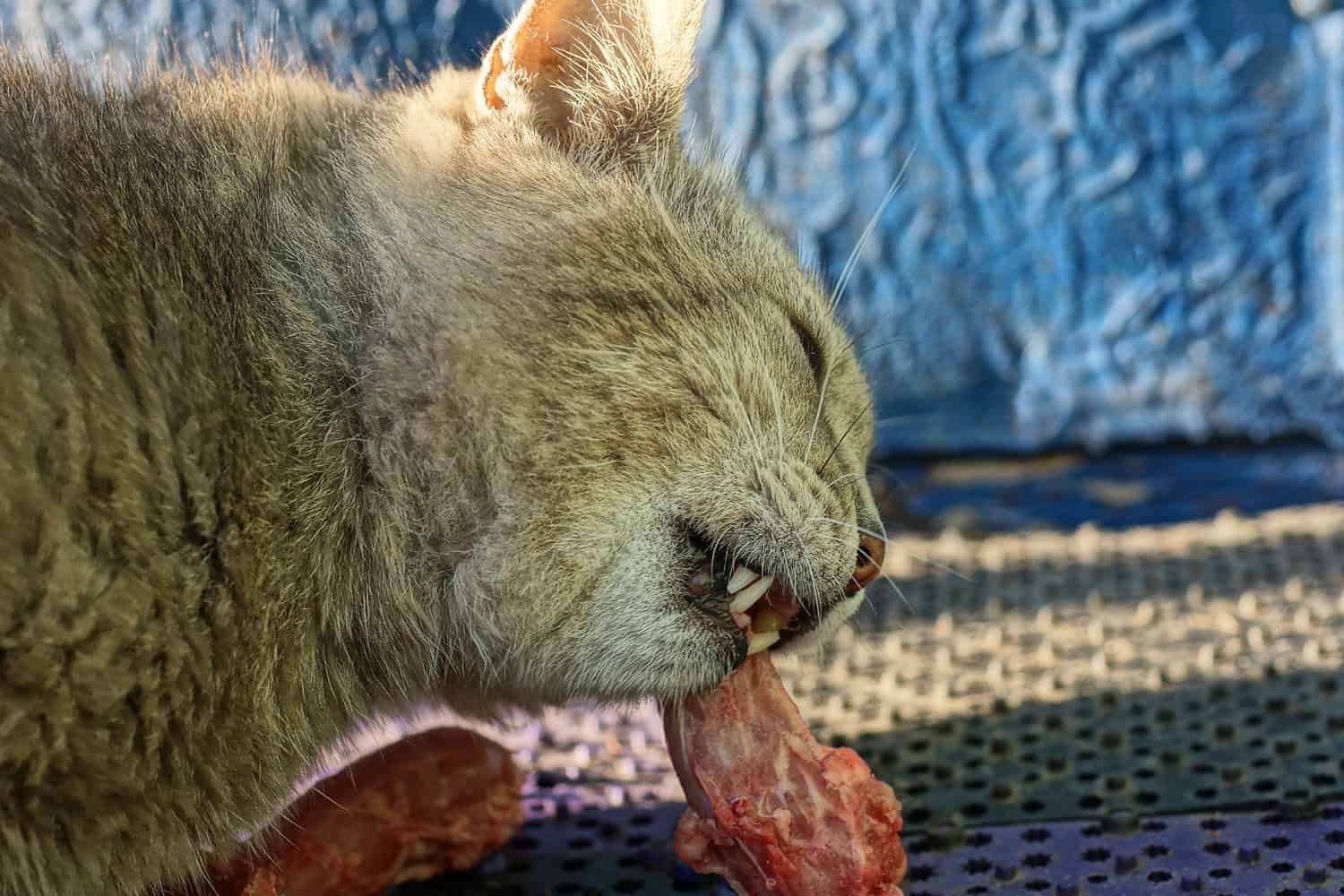
Bones are the main source of calcium in most homemade raw diets for cats, but there are alternative ways of supplementing the food with calcium.
Calcium is essential to a cat's health and a calcium-deficient diet can be extremely dangerous to your cat's health, and potentially fatal.
The wrong balance of calcium-to-phosphorus can be critical as well, so ensure you're feeding a balanced and complete diet, including supplementation if required.
Follow an established recipe or the prey model raw feeding guidelines, and don't make substitutions unless you are absolutely sure of the nutritional implications of the changes you are making.
When in doubt, consult with a pet nutritionist.
Preparing Raw Cat Food At Home - Tools Of The Trade
Feeding a raw-based diet doesn’t have to be complicated.
As more cat owners choose to feed raw, the market for commercial products increases in size, and easy thaw-and-serve solutions are readily available.
If you do choose to prepare a homemade raw diet for your cats, then keep on reading.
This article brings together a nice list of tools our members use for preparing and feeding raw.
Please take a minute to read about the safety issues associated with preparing and feeding raw.
These are not necessarily unique to preparing raw food for pets. If you feed kibble, or if you prepare raw meat, chicken or eggs for the humans in your household, take care to practice safe food handling.
The Freezer
Depending on the number of cats in your household, you may want to invest in a good freezer.
Many of our members stock up on meat while it’s on sale, or just prepare food in advance, freezing up serving-size portions for later use.
The freezer can also play an active role in the preparation process, as it can help destroy potential pathogens.
Freezing meat for 24 hours at 0F (-18C) ensures your meat is free of toxoplasma. The freezer temperature should be monitored with a freezer thermometer.
Don’t be deterred by the expense. A second-hand freezer can be just right for the job. Even a brand new freezer can pay back its price within a few months.
The Meat Grinder
Not every raw-based diet calls for grinding meat. In fact, there are distinct benefits to letting the cat chew on her food.
That said, many owners opt for feeding ground and many cats refuse anything else as they begin their journey into raw.
If you do feed ground, you’ll need a high-quality grinder that can handle bone as well as meat. At least one of our members' reports using a manual grinder, but these require quite a bit of strength to operate.
A strong electric grinder is probably a better choice for most cat owners.
When buying a grinder, go for a powerful model. Even if your initial recipes don't use bones, you may want to experiment with bones down the road and you should get a grinder that can deal with those.
The Scales
Working by a recipe often requires accurate measuring. A kitchen or a postal scale is what most of our members use.
Measuring cups and spoons can also come in handy.
Remember, it is your responsibility to keep the cat’s diet complete and balanced. Opting for a homemade diet, whether raw or cooked, means using a nutritionally balanced recipe and sticking to it.
Follow the instructions without deviation and use the scales to measure the ingredients.
Utensils
These are not necessarily any different from what you use in your kitchen to prepare meat for human consumption. Our member LDG recommends a good pair of scissors, along with an easy-to-use quality sharpener (works well for knives too!)
Other utensils mentioned by our raw-feeding members include large mixing bowls, large mixing spoons, and push pins (to poke holes in the fish oil gel caps used as supplements).
Storage Options
Feeding raw doesn’t mean you need to work on preparing meals every day. Many of our members make a stock of raw meals ahead of time, storing them in the freezer for future use.
Ziploc bags, disposable food containers, and even ice cube trays are all used to prepare serving-sized meals that can be thawed and served.
Keeping it Hygienic
Last, but not least, keep things clean and hygienic. Just as with preparing raw meat for human consumption, have separate cutting boards for raw meat and never use the same ones to prepare vegetables or other produce.
Our member mrsgreenjenes reports using a plastic cutting "sheet" on top of the wooden cutting board for ease in cleaning.
Washing and disinfecting utensils are crucial. Anything that you would usually use to clean up after preparing raw meat works well here.
Clorox and paper towels are always handy, but you can use any other bacterial disinfectant.
Feeding Raw To Cats - Safety Concerns
Maybe you've been reading about raw.
You're feeling excited about the idea of regaining control over your pet's food. The thought of feeding them a fresh, minimally processed diet also thrills you.
When you tell your vet you're considering a raw food diet for your cat, their response surprises you. They say, "I don't recommend it. Feeding a raw diet can be dangerous."
Then a quick search online reveals that the American Veterinary Medical Association (AVMA) has a policy on raw or undercooked animal-source protein diets for pets that is essentially an “anti-raw” stance. This is ostensibly taken out of concern for “public health risks” and the risk to our pets of contracting a foodborne illness.
Now you’re concerned!
AVMA's Policy: Another Perspective
For a different take on the reason for the AVMA policy, please see the TCS thread “AVMA to vote to take a stand against raw feeding.” Also see a summary of responses to the policy by veterinarians, a Ph.D. pet nutritional advisor, and a pet food company in this article at CatCentric.org.
So what are the raw diet dangers typically cited? Bacteria (especially salmonella), parasites, bones, and nutritional deficiencies.
This article addresses these but focuses primarily on the public health risks. Balancing and properly feeding raw (including bone-in meals) will be covered in more depth in subsequent articles.
The Importance of Doing Raw Right
Concerned? Good, you should be. Being concerned about these potential problems will help ensure that you feed raw right.
As TCS member Carolina states, “The way I see it, raw is the best diet there is, when done right. That includes what I call ‘respecting the meat.’
Know how to buy, handle, store, balance, and feed. As long as you know that, it is a safe diet.”
Of course, most of the negative assumptions about raw feeding are directed at homemade raw diets.
But for a growing number of pet owners, feeding raw doesn't have to mean preparing homemade food.
Interestingly, many vets are unaware of the numerous commercial raw diet options available in countries like the U.S. and Canada. My vet, for instance, didn't know about them.
There are frozen raw products bearing AAFCO “Complete and Balanced” statements; commercial supplements that balance raw (or cooked) meat (available in North America and Europe). Also there are sterile balanced & complete commercially frozen raw foods, treated with a process that uses almost no heat called High-Pressure Pasteurization.
Managing the Risks
In regard to pathogens and their risk to our cats, raw feeders cite the cat’s natural evolutionary defenses.
Cats have highly acidic digestive systems. These systems contain an enzyme called lysozyme that attacks bacteria and other pathogens. Additionally, they have very short digestive tracts.
Animal-based meals take on average just 12 hours to pass completely through, giving bacteria little time to proliferate.
Many stray and feral cats eat garbage or old carcasses as scavengers. This showcases the strength of their natural defenses, as they often experience no ill effects.
However, this doesn't address the potentially unnaturally high bacterial loads in mass-produced meats. Cats can and do become sick from contaminants.
The good news is that as in people, these are treatable if not self-resolving. Additionally, for the most part, problems can be avoided altogether with a little care:
- Know the source of your ingredients
- Portion your meat and freeze it for up to several weeks prior to use.
- Freezing for 24 hours at 0F (-18C) renders T. gondii oocysts (responsible for toxoplasmosis) harmless. The freezer temperature should be monitored with a freezer thermometer.
- Meat supplies in the U.S. are considered free of Trichinosis, formerly a potential issue primarily in pork. For those in other countries where it may be a problem, Trichinella larva can be rendered harmless by freezing meat for 3 weeks. There are resistant strains: they are found in bears, wild boar, arctic fox and the walrus.
- Add probiotics to your cat's diet for enhanced intestinal tract health.
- Use safe-handling, storing, and thawing techniques – the same methods used for handling meat for the family.
- Do not leave any uneaten food out for longer than 30 minutes.
Salmonella
Salmonella is typically the number one concern when someone considers feeding raw. While it is a real concern, perspective is important.
Many pets already harbor these bacteria as a part of their normal gastrointestinal flora.
Salmonella in Healthy Pets
A 2002 study used by the AVMA to formulate their policy indicates that 36% of all healthy dogs and 18% of healthy cats are carriers of salmonella, irrespective of the type of food consumed. Proper handling of both food AND proper cleaning of the litter box are required with ALL pet diets.
You may not be aware of this, but our fruits and vegetables often face recalls due to salmonella. Spices and nuts are also frequently recalled for the same reason.
Ground annatto, basil, black pepper, chile, packaged sliced fruit, dried egg products, alfalfa sprouts, and tomatoes have all been recalled in the U.S. this year alone (as of April 2014) due to salmonella contamination.
Food Safety Principles Apply to All Pet Foods
Many people don’t realize that the basic principles of food safety apply to their pets’ foods too:
- Dry food also harbors salmonella, and the FDA provides safe handling instructions for canned and dry pet food and treats.
- There have been 128 cases of human salmonellosis associated with handling kibble. To date, none have been reported from feeding raw cat food.
- No matter what food you feed, our cats can naturally harbor and shed salmonella. According to the Natural Institutes of Health, salmonella infection is usually self-limiting, lasting 2–7 days. The goal of treatment is to make you feel better and avoid dehydration.
- Salmonella infection is rarely seen in cats. Most felines will only be carriers of the bacteria. They won't show any clinical symptoms.
- According to the Merck Veterinary Manual, salmonella is a normal part of the gut flora of dogs and cats (and other animals). But kittens and cats with weak immune systems are more susceptible to illness, so be aware of what to look for and do not delay taking your pet to see a vet: Salmonella in Cats at VetInfo.
- Proper food handling and storage reduce the risk of infection to both you and your pet.
- A 2007 study in therapy dogs found that dogs fed raw meat were more likely to shed salmonella than dogs fed other diets. Even though shedding of salmonella was reported with every type of diet fed. This is consistent with the 2002 study cited by the AVMA.
- The primary point of transference of salmonella from pet to human is feces (if safe food handling practices are implemented). This is equally true no matter what type of diet is fed. So practice safe scooping, and wash your hands after cleaning the litter box.
Safe Handling Practices for Pet Food (Raw or Otherwise)
This is a representative list of hygienic measures. Please refer to the FDA and the CDC for more complete information.
- When feeding homemade raw food, use only inspected meats suitable for human consumption. (e.g. in the U.S. that is the USDA)
- Wash hands after handling any pet food, raw or otherwise
- Regularly wash and disinfect with a mild bleach solution bowls, utensils, food preparation surfaces, and implements
- Avoid cross-contamination by using separate preparation surfaces for different ingredients
- Properly store canned and raw foods in the refrigerator or freezer
- Thaw frozen foods overnight in the refrigerator, not at room temperature
- Do not allow pets to consume raw food products outside of the dish. (Or areas that can easily be cleaned and disinfected)
- Dispose of unconsumed meal portions
- Avoid exposing young children, the elderly, or the ill to raw food ingredients or kibble
| Type | Risk duringpreparation | Risk of secondary infection from a carrier animal |
| Dry Food | + | + |
| Canned Food | - | - |
| Raw Food (Non-HPP treated) | + | + |
Parasites
Parasites are sometimes mentioned as a concern when feeding raw food to pets. Common parasites include roundworm, tapeworm, and hookworm.
These are primarily found in the gastrointestinal tracts of prey species.
When feeding raw, we normally do not feed guts to our pets. Instead, we purchase “cuts” of meat that do not include the stomach, intestines, or colon.
As long as we do not feed animal guts to our pets, there is essentially no risk of contracting GI parasites.
Bones
The primary focus of this article is on public health risks.
The topic of how to properly feed RAW bones to your cat will be covered in a separate article titled "Prey Model Raw: the Basics.” It's important to note that improperly feeding bones poses a risk when making homemade cat food.
If feeding ground, properly grinding bones present little risk.
But when feeding bone-in meals, two basic principles minimize the potential choking, obstruction, or perforation hazard:
- NEVER feed cooked bones, even if ground;
- Think “mouse-sized” and feed appropriately sized bones to your cat (that would naturally eat very small prey animals).
Nutritional Deficiency
Do your research. Making nutritionally balanced homemade cat food is not rocket science. However, it does take time to learn how to do it properly.
Ensure that the recipe you choose is based on reliable information.
A raw food diet can feel like a lifesaver to someone that has a pet with allergies or IBD. Especially when the fresh food – minimally processed, with no fillers or preservatives – stops an ongoing battle with vomiting or diarrhea.
But well-meaning people may feed unbalanced diets out of a lack of knowledge.
Feeding a raw diet is not just putting down some raw meat or offering a raw meaty bone to your cat.
There are different forms and styles of raw food and different philosophies of what a “balanced diet” means for our cats.
But at the end of the day, whether feeding ground food or prey model raw, our cats have certain nutritional needs. If we do not meet them, we are doing more harm than good in feeding our cats a homemade diet.
The discussion of properly balancing homemade foods will be explored in subsequent articles.
But it is essential to understand that there is more to feeding raw than providing meat or a bone-in meal.
To learn more, the Raw & Home-Cooked Cat Food Forum of TheCatSite has an excellent collection of resources. Experienced members are also ready to assist you.
Final Thoughts
Safety is typically the first thing cat owners worry about when considering feeding raw. But by taking what should be considered normal precautions, the potential risk to ourselves and our pets is mitigated.
Feeding raw does mean increased exposure to potential pathogens. Maintaining safe handling practices reduces the risk to a minimum but does not eliminate it.
If you have immunocompromised individuals in your household, whether human or animal, consider other feeding options. Sterile raw (raw treated with HPP) or canned food might be safer for everyone involved.
As mentioned, there have been many reported cases of human infection with salmonella from handling kibble.
So, regardless of the food you choose for your pet, always practice basic hygiene. This applies in the kitchen and when handling the litter box.
SIGN UP FOR THECATSITE'S EMAIL UPDATES >
Written by Laurie Goldstein
Pictures by Furmonster Mom and Beth Laubenthal
Laurie Goldstein is a CFA Charterholder. In addition to her work as an equity analyst, she applies her research skill to all things cat. She focuses on nutrition and advocacy for feral cat management via trap-neuter-return (TNR) and educational research on cat predation. Learn more about feral cats on her website http://www.StrayPetAdvocacy.org.
Note: We may get commissions for purchases made through links on this page.


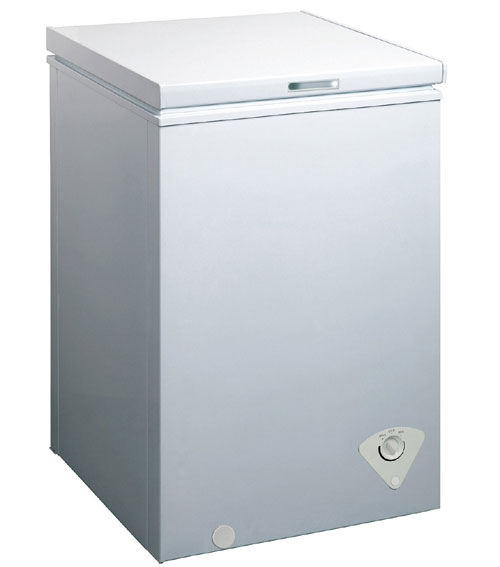
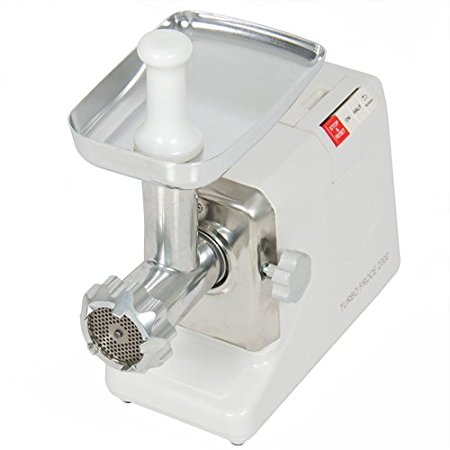

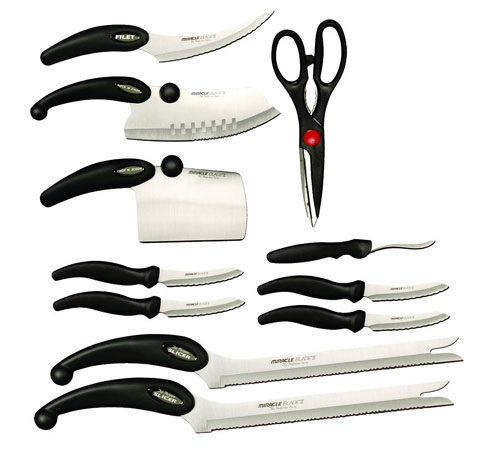
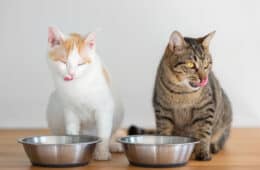

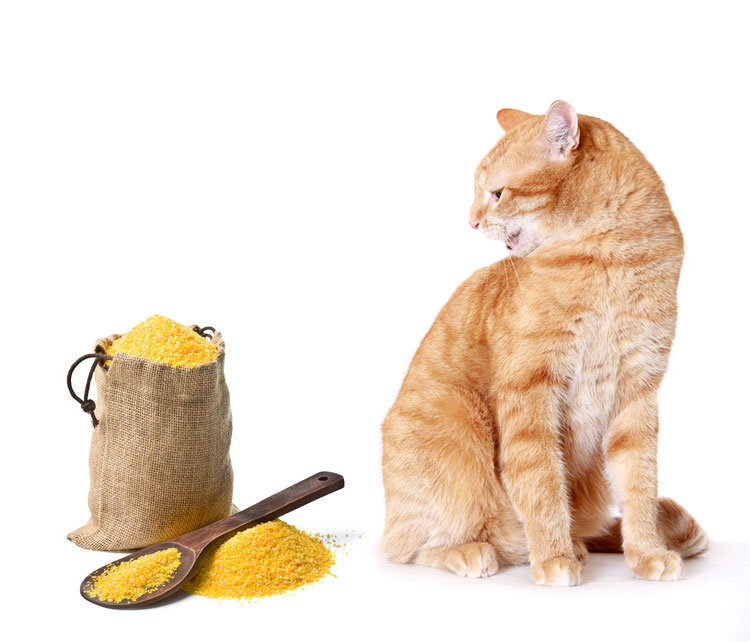
One comment on “Homemade & Raw Food For Cats – A Collection of Guides”